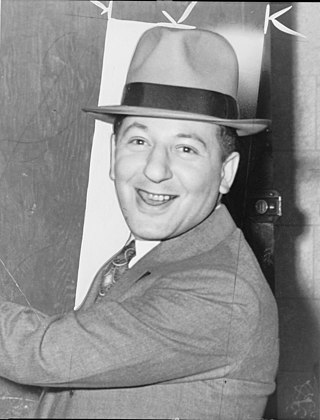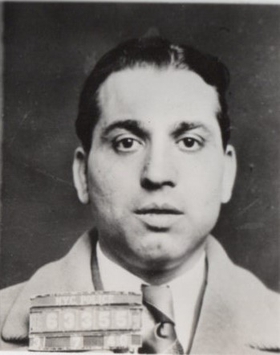
Tony Curtis was an American actor with a career that spanned six decades, achieving the height of his popularity in the 1950s and early 1960s. He acted in more than 100 films, in roles covering a wide range of genres. In his later years, Curtis made numerous television appearances.

Benjamin "Bugsy" Siegel sometimes known as Ben Siegel, was an American mobster who was a driving force behind the development of the Las Vegas Strip. Siegel was influential within the Jewish Mob, along with his childhood friend and fellow gangster Meyer Lansky, and he also held significant influence within the Italian-American Mafia and the largely Italian-Jewish National Crime Syndicate. Described as handsome and charismatic, he became one of the first front-page celebrity gangsters.
Murder, Inc. was an organized crime group active from 1929 to 1941 that acted as the enforcement arm of the National Crime Syndicate – a closely connected criminal organization that included the Italian-American Mafia, the Jewish Mob, and other criminal organizations in New York City and elsewhere. Murder, Inc. was composed of Jewish and Italian-American gangsters, and members were mainly recruited from poor and working-class Jewish and Italian neighborhoods in Manhattan and Brooklyn. It was initially headed by Louis "Lepke" Buchalter and later by Albert "Mad Hatter" Anastasia.

Louis Capone was a New York organized crime figure who became a supervisor for Murder, Inc. Louis Capone was not related to Al Capone, the boss of the Chicago Outfit. Capone was convicted of murder in 1941, and sentenced to death. He was electrocuted at Sing Sing Prison on March 4, 1944.

Louis Buchalter, known as Louis Lepke or Lepke Buchalter, was an American mobster and head of the Mafia hit squad Murder, Inc., during the 1930s. Buchalter was one of the premier labor racketeers in New York City during that era.
The National Crime Syndicate was a multi-ethnic, closely connected, American confederation of several criminal organizations. It mostly consisted of and was led by the closely interconnected Italian American Mafia and Jewish Mob. It also involved other criminal organizations such as the Irish Mob and to a lesser extent African American groups. Hundreds of murders were committed by Murder, Inc. on behalf of the National Crime Syndicate during the 1930s and 1940s.

Harry "Happy" Maione was a New York mobster who served as a hitman for Murder, Inc. during the 1930s. Maione was called "Happy" because his face displayed an eternal scowl.

Murder, Inc. is a 1960 American gangster film starring Stuart Whitman, May Britt, Henry Morgan, Peter Falk, and Simon Oakland. Filmed in Cinemascope and directed by Burt Balaban and Stuart Rosenberg, the film was based on the true story of Murder, Inc., a Brooklyn gang that operated in the 1930s.
Albert Tannenbaum, nicknamed Allie or Tick-Tock, was a Jewish-American hitman for Murder, Inc., the enforcement arm of the National Crime Syndicate, during the 1930s.
Harry "Big Greenie" Greenberg was an associate and childhood friend of Benjamin "Bugsy" Siegel, and an employee of both Charlie "Lucky" Luciano and Meyer Lansky.

Yoram Globus is an Israeli–American film producer, cinema owner, and distributor. He has been involved in over 300 full-length motion pictures and he is most known for his association with The Cannon Group, Inc., an American film production company, which he co-owned with his cousin Menahem Golan.
The Bugs (Bugsy) and Meyer Mob was a Jewish-American street gang in Manhattan, New York City's Lower East Side. It was formed and headed by mobsters Bugsy Siegel and Meyer Lansky during their teenage years shortly after the start of Prohibition. The Bugs and Meyer mob acted as a predecessor to Murder, Inc.

Jewish-American organized crime initially emerged within the American Jewish community during the late 19th and early 20th centuries. In media and popular culture, it has variously been referred to as the Jewish Mob, the Jewish Mafia, the Kosher Mob, the Kosher Mafia, the Yiddish Connection, and Kosher Nostra or Undzer Shtik. The last two of these terms are direct references to the Italian cosa nostra; the former is a play on the word for kosher, referring to Jewish dietary laws, while the latter is a calque of the Italian phrase 'cosa nostra' into Yiddish, which was at the time the predominant language of the Jewish diaspora in the United States.

Meyer (1908–1931), Irving (1904–1931) and William Shapiro (1911–1934), collectively known as the Shapiro Brothers were the leaders of a group of Jewish-American mobsters from New York City and based in Williamsburg. Well established in the local garment industry, long dominated by Jacob "Gurrah" Shapiro and Louis "Lepke" Buchalter since the 1927 death of Jacob "Little Augie" Orgen, the two began to move against them in the summer of 1931. As the two sides battled for the garment industry in Brooklyn, Irving and Meyer Shapiro were killed by Joseph and Louis Amberg; Irving was gunned down near his apartment on July 11, and Meyer was found shot to death in the basement of a tenement building on Manhattan's Lower East Side on September 17, 1931. Three years later, on orders from Buchalter, Willie Shapiro was finally killed by Murder, Inc. members Martin "Bugsy" Goldstein and Abe "Kid Twist" Reles, supposedly being buried alive in a sandpit in the marshland of Canarsie by Reles, the Amberg brothers, and Frank Abbandando and Harry Maione on the night of July 20, 1934.

Jacob "Little Augie" Orgen was a New York gangster involved in bootlegging and labor racketeering during Prohibition.

Jacob "Gurrah" Shapiro was a New York mobster who, with his partner Louis "Lepke" Buchalter, controlled industrial labor racketeering in New York for two decades and established the Murder, Inc. organization.
Hyman "Curly" Holtz, also known as "Little Hymie", was a New York labor racketeer who began working as a labor slugger for Jacob "Little Augie" Orgen during the early 1920s.
Abraham "Whitey" Friedman was a New York mobster and former associate of Nathan "Kid Dropper" Kaplan and later for labor racketeers Louis "Lepke" Buchalter and Jacob "Gurrah" Shapiro as an enforcer in New York's garment district during the 1920s and 1930s. One of many former associates killed by Murder, Inc. on the orders of Buchalter, he had recently been called in for questioning by investigators with crusading District Attorney Thomas E. Dewey, and was gunned down as he was walking near his home on East 96th Street in Brooklyn during the early evening of April 25, 1939. Before his murder, Friedman was suspected of informing on Buchalter.
Isadore or Irving Friedman, also known under the alias Danny Field, was a New York mobster and an associate of labor racketeer Louis "Lepke" Buchalter. He later agreed to testify against Buchalter on behalf of District Attorney Thomas E. Dewey as one of several high-profile witnesses scheduled to testify against Buchalter; however, he was murdered with Louis Cohen on January 28, 1939, shortly before his court appearance. Jacob "Kuppy" Midgen was believed to be the killer.
Oz Almog is an Israeli and Austrian artist, born on 15 April 1956, in Kfar Saba, Israel.











